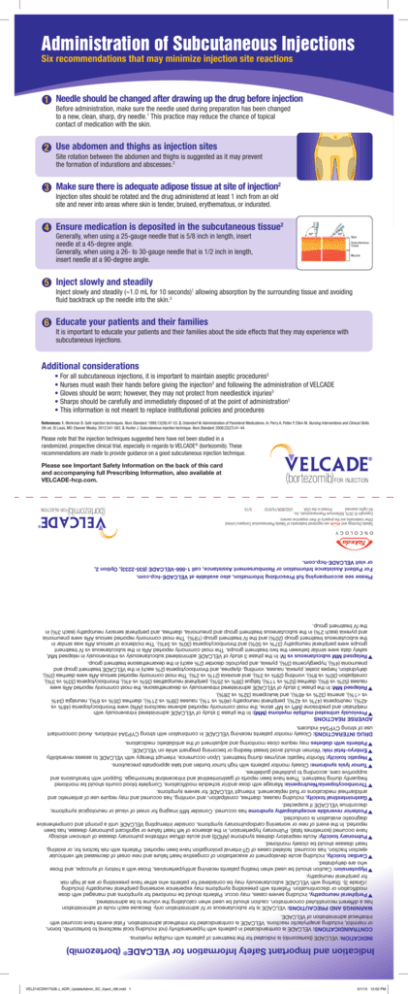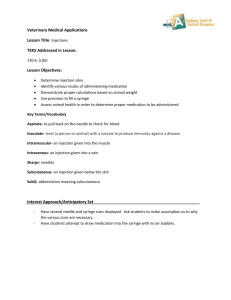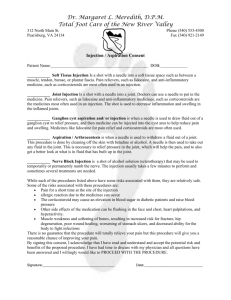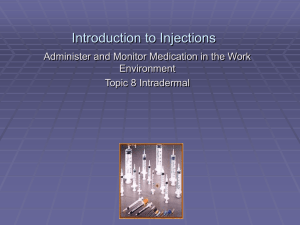
VEL214CDNY7528 J_ADR_UpdateAdmin_SC_Inject_r06.indd 1
5/1/15 12:02 PM
Indication and Important Safety Information for VELCADE® (bortezomib)
INDICATION: VELCADE (bortezomib) is indicated for the treatment of patients with multiple myeloma.
CONTRAINDICATIONS: VELCADE is contraindicated in patients with hypersensitivity (not including local reactions) to bortezomib, boron,
or mannitol, including anaphylactic reactions. VELCADE is contraindicated for intrathecal administration. Fatal events have occurred with
intrathecal administration of VELCADE.
WARNINGS AND PRECAUTIONS: VELCADE is for subcutaneous or IV administration only. Because each route of administration
has a different reconstituted concentration, caution should be used when calculating the volume to be administered.
▼Peripheral neuropathy, including severe cases, may occur. Patients should be monitored for symptoms and managed with dose
modification or discontinuation. Patients with preexisting symptoms may experience worsening peripheral neuropathy (including
≥Grade 3). Starting with VELCADE subcutaneously may be considered for patients who either have preexisting or are at high risk
for peripheral neuropathy.
▼Hypotension: Caution should be used when treating patients receiving antihypertensives, those with a history of syncope, and those
who are dehydrated.
▼Cardiac toxicity, including acute development or exacerbation of congestive heart failure and new onset of decreased left ventricular
ejection fraction, has occurred. Isolated cases of QT-interval prolongation have been reported. Patients with risk factors for, or existing,
heart disease should be closely monitored.
▼Pulmonary toxicity: Acute respiratory distress syndrome (ARDS) and acute diffuse infiltrative pulmonary disease of unknown etiology
have occurred (sometimes fatal). Pulmonary hypertension, in the absence of left heart failure or significant pulmonary disease, has been
reported. In the event of new or worsening cardiopulmonary symptoms, consider interrupting VELCADE until a prompt and comprehensive
diagnostic evaluation is conducted.
▼Posterior reversible encephalopathy syndrome has occurred. Consider MRI imaging for onset of visual or neurological symptoms;
discontinue VELCADE if suspected.
▼Gastrointestinal toxicity, including nausea, diarrhea, constipation, and vomiting, has occurred and may require use of antiemetic and
antidiarrheal medications or fluid replacement. Interrupt VELCADE for severe symptoms.
▼Thrombocytopenia/Neutropenia: Manage with dose and/or schedule modifications. Complete blood counts should be monitored
frequently during treatment. There have been reports of gastrointestinal and intracerebral hemorrhage. Support with transfusions and
supportive care, according to published guidelines.
▼Tumor lysis syndrome: Closely monitor patients with high tumor burden and take appropriate precautions.
▼Hepatic toxicity: Monitor hepatic enzymes during treatment. Upon occurrence, interrupt therapy with VELCADE to assess reversibility.
▼Embryo-fetal risk: Women should avoid breast-feeding or becoming pregnant while on VELCADE.
▼Patients with diabetes may require close monitoring and adjustment of the antidiabetic medications.
DRUG INTERACTIONS: Closely monitor patients receiving VELCADE in combination with strong CYP3A4 inhibitors. Avoid concomitant
use of strong CYP3A4 inducers.
ADVERSE REACTIONS
▼Previously untreated multiple myeloma (MM): In the phase 3 study of VELCADE administered intravenously with
melphalan and prednisone (MP) vs MP alone, the most commonly reported adverse reactions (ARs) were thrombocytopenia (48% vs
42%), neutropenia (47% vs 42%), peripheral neuropathy (46% vs 1%), nausea (39% vs 21%), diarrhea (35% vs 6%), neuralgia (34%
vs <1%), anemia (32% vs 46%), and leukopenia (32% vs 28%).
▼Relapsed MM: In the phase 3 study of VELCADE administered intravenously vs dexamethasone, the most commonly reported ARs were
nausea (52% vs 9%), diarrhea (52% vs 11%), fatigue (39% vs 25%), peripheral neuropathies (35% vs 4%), thrombocytopenia (33% vs 3%),
constipation (30% vs 8%), vomiting (29% vs 3%), and anorexia (21% vs 2%). The most commonly reported serious ARs were diarrhea (3%),
dehydration, herpes zoster, pyrexia, nausea, vomiting, dyspnea, and thrombocytopenia (2% each) in the VELCADE treatment group and
pneumonia (4%), hyperglycemia (3%), pyrexia, and psychotic disorder (2% each) in the dexamethasone treatment group.
▼Relapsed MM subcutaneous vs IV: In the phase 3 study of VELCADE administered subcutaneously vs intravenously in relapsed MM,
safety data were similar between the two treatment groups. The most commonly reported ARs in the subcutaneous vs IV treatment
groups were peripheral neuropathy (37% vs 50%) and thrombocytopenia (30% vs 34%). The incidence of serious ARs was similar in
the subcutaneous treatment group (20%) and the IV treatment group (19%). The most commonly reported serious ARs were pneumonia
and pyrexia (each 2%) in the subcutaneous treatment group and pneumonia, diarrhea, and peripheral sensory neuropathy (each 3%) in
the IV treatment group.
Please see accompanying full Prescribing Information, also available at VELCADE-hcp.com.
For Patient Assistance Information or Reimbursement Assistance, call 1-866-VELCADE (835-2233), Option 2,
or visit VELCADE-hcp.com.
Takeda Oncology and are registered trademarks of Takeda Pharmaceutical Company Limited.
Other trademarks are the property of their respective owners.
Copyright © 2015, Millennium Pharmaceuticals, Inc.
All rights reserved.
Printed in the USA
USO/BOR/15/0151
5/15
Please see Important Safety Information on the back of this card
and accompanying full Prescribing Information, also available at
VELCADE-hcp.com.
Please note that the injection techniques suggested here have not been studied in a
randomized, prospective clinical trial, especially in regards to VELCADE® (bortezomib). These
recommendations are made to provide guidance on a good subcutaneous injection technique.
References: 1. Workman B. Safe injection techniques. Nurs Standard. 1999;13(39):47-53. 2. Ostendorf W. Administration of Parenteral Medications. In: Perry A, Potter P, Elkin M. Nursing Interventions and Clinical Skills.
5th ed. St Louis, MO: Elsevier Mosby. 2012:541-583. 3. Hunter J. Subcutaneous injection technique. Nurs Standard. 2008;22(27):41-44.
•For all subcutaneous injections, it is important to maintain aseptic procedures3
•Nurses must wash their hands before giving the injection3 and following the administration of VELCADE
•Gloves should be worn; however, they may not protect from needlestick injuries3
•Sharps should be carefully and immediately disposed of at the point of administration3
•This information is not meant to replace institutional policies and procedures
Additional considerations
It is important to educate your patients and their families about the side effects that they may experience with
subcutaneous injections.
6 Educate your patients and their families
Inject slowly and steadily (≈1.0 mL for 10 seconds)1 allowing absorption by the surrounding tissue and avoiding
fluid backtrack up the needle into the skin.3
5 Inject slowly and steadily
Generally, when using a 25-gauge needle that is 5/8 inch in length, insert
needle at a 45-degree angle.
Generally, when using a 26- to 30-gauge needle that is 1/2 inch in length,
insert needle at a 90-degree angle.
4 Ensure medication is deposited in the subcutaneous tissue2
Injection sites should be rotated and the drug administered at least 1 inch from an old
site and never into areas where skin is tender, bruised, erythematous, or indurated.
3 Make sure there is adequate adipose tissue at site of injection2
Site rotation between the abdomen and thighs is suggested as it may prevent
the formation of indurations and abscesses.2
2 Use abdomen and thighs as injection sites
efore administration, make sure the needle used during preparation has been changed
B
to a new, clean, sharp, dry needle.1 This practice may reduce the chance of topical
contact of medication with the skin.
1 Needle should be changed after drawing up the drug before injection
Six recommendations that may minimize injection site reactions
Administration of Subcutaneous Injections
VEL214CDNY7528 J_ADR_UpdateAdmin_SC_Inject_r06.indd 1
5/1/15 12:02 PM
Indication and Important Safety Information for VELCADE® (bortezomib)
INDICATION: VELCADE (bortezomib) is indicated for the treatment of patients with multiple myeloma.
CONTRAINDICATIONS: VELCADE is contraindicated in patients with hypersensitivity (not including local reactions) to bortezomib, boron,
or mannitol, including anaphylactic reactions. VELCADE is contraindicated for intrathecal administration. Fatal events have occurred with
intrathecal administration of VELCADE.
WARNINGS AND PRECAUTIONS: VELCADE is for subcutaneous or IV administration only. Because each route of administration
has a different reconstituted concentration, caution should be used when calculating the volume to be administered.
▼Peripheral neuropathy, including severe cases, may occur. Patients should be monitored for symptoms and managed with dose
modification or discontinuation. Patients with preexisting symptoms may experience worsening peripheral neuropathy (including
≥Grade 3). Starting with VELCADE subcutaneously may be considered for patients who either have preexisting or are at high risk
for peripheral neuropathy.
▼Hypotension: Caution should be used when treating patients receiving antihypertensives, those with a history of syncope, and those
who are dehydrated.
▼Cardiac toxicity, including acute development or exacerbation of congestive heart failure and new onset of decreased left ventricular
ejection fraction, has occurred. Isolated cases of QT-interval prolongation have been reported. Patients with risk factors for, or existing,
heart disease should be closely monitored.
▼Pulmonary toxicity: Acute respiratory distress syndrome (ARDS) and acute diffuse infiltrative pulmonary disease of unknown etiology
have occurred (sometimes fatal). Pulmonary hypertension, in the absence of left heart failure or significant pulmonary disease, has been
reported. In the event of new or worsening cardiopulmonary symptoms, consider interrupting VELCADE until a prompt and comprehensive
diagnostic evaluation is conducted.
▼Posterior reversible encephalopathy syndrome has occurred. Consider MRI imaging for onset of visual or neurological symptoms;
discontinue VELCADE if suspected.
▼Gastrointestinal toxicity, including nausea, diarrhea, constipation, and vomiting, has occurred and may require use of antiemetic and
antidiarrheal medications or fluid replacement. Interrupt VELCADE for severe symptoms.
▼Thrombocytopenia/Neutropenia: Manage with dose and/or schedule modifications. Complete blood counts should be monitored
frequently during treatment. There have been reports of gastrointestinal and intracerebral hemorrhage. Support with transfusions and
supportive care, according to published guidelines.
▼Tumor lysis syndrome: Closely monitor patients with high tumor burden and take appropriate precautions.
▼Hepatic toxicity: Monitor hepatic enzymes during treatment. Upon occurrence, interrupt therapy with VELCADE to assess reversibility.
▼Embryo-fetal risk: Women should avoid breast-feeding or becoming pregnant while on VELCADE.
▼Patients with diabetes may require close monitoring and adjustment of the antidiabetic medications.
DRUG INTERACTIONS: Closely monitor patients receiving VELCADE in combination with strong CYP3A4 inhibitors. Avoid concomitant
use of strong CYP3A4 inducers.
ADVERSE REACTIONS
▼Previously untreated multiple myeloma (MM): In the phase 3 study of VELCADE administered intravenously with
melphalan and prednisone (MP) vs MP alone, the most commonly reported adverse reactions (ARs) were thrombocytopenia (48% vs
42%), neutropenia (47% vs 42%), peripheral neuropathy (46% vs 1%), nausea (39% vs 21%), diarrhea (35% vs 6%), neuralgia (34%
vs <1%), anemia (32% vs 46%), and leukopenia (32% vs 28%).
▼Relapsed MM: In the phase 3 study of VELCADE administered intravenously vs dexamethasone, the most commonly reported ARs were
nausea (52% vs 9%), diarrhea (52% vs 11%), fatigue (39% vs 25%), peripheral neuropathies (35% vs 4%), thrombocytopenia (33% vs 3%),
constipation (30% vs 8%), vomiting (29% vs 3%), and anorexia (21% vs 2%). The most commonly reported serious ARs were diarrhea (3%),
dehydration, herpes zoster, pyrexia, nausea, vomiting, dyspnea, and thrombocytopenia (2% each) in the VELCADE treatment group and
pneumonia (4%), hyperglycemia (3%), pyrexia, and psychotic disorder (2% each) in the dexamethasone treatment group.
▼Relapsed MM subcutaneous vs IV: In the phase 3 study of VELCADE administered subcutaneously vs intravenously in relapsed MM,
safety data were similar between the two treatment groups. The most commonly reported ARs in the subcutaneous vs IV treatment
groups were peripheral neuropathy (37% vs 50%) and thrombocytopenia (30% vs 34%). The incidence of serious ARs was similar in
the subcutaneous treatment group (20%) and the IV treatment group (19%). The most commonly reported serious ARs were pneumonia
and pyrexia (each 2%) in the subcutaneous treatment group and pneumonia, diarrhea, and peripheral sensory neuropathy (each 3%) in
the IV treatment group.
Please see accompanying full Prescribing Information, also available at VELCADE-hcp.com.
For Patient Assistance Information or Reimbursement Assistance, call 1-866-VELCADE (835-2233), Option 2,
or visit VELCADE-hcp.com.
Takeda Oncology and are registered trademarks of Takeda Pharmaceutical Company Limited.
Other trademarks are the property of their respective owners.
Copyright © 2015, Millennium Pharmaceuticals, Inc.
All rights reserved.
Printed in the USA
USO/BOR/15/0151
5/15
Please see Important Safety Information on the back of this card
and accompanying full Prescribing Information, also available at
VELCADE-hcp.com.
Please note that the injection techniques suggested here have not been studied in a
randomized, prospective clinical trial, especially in regards to VELCADE® (bortezomib). These
recommendations are made to provide guidance on a good subcutaneous injection technique.
References: 1. Workman B. Safe injection techniques. Nurs Standard. 1999;13(39):47-53. 2. Ostendorf W. Administration of Parenteral Medications. In: Perry A, Potter P, Elkin M. Nursing Interventions and Clinical Skills.
5th ed. St Louis, MO: Elsevier Mosby. 2012:541-583. 3. Hunter J. Subcutaneous injection technique. Nurs Standard. 2008;22(27):41-44.
•For all subcutaneous injections, it is important to maintain aseptic procedures3
•Nurses must wash their hands before giving the injection3 and following the administration of VELCADE
•Gloves should be worn; however, they may not protect from needlestick injuries3
•Sharps should be carefully and immediately disposed of at the point of administration3
•This information is not meant to replace institutional policies and procedures
Additional considerations
It is important to educate your patients and their families about the side effects that they may experience with
subcutaneous injections.
Inject slowly and steadily (≈1.0 mL for 10 seconds)1 allowing absorption by the surrounding tissue and avoiding
fluid backtrack up the needle into the skin.3
Generally, when using a 25-gauge needle that is 5/8 inch in length, insert
needle at a 45-degree angle.
Generally, when using a 26- to 30-gauge needle that is 1/2 inch in length,
insert needle at a 90-degree angle.
Injection sites should be rotated and the drug administered at least 1 inch from an old
site and never into areas where skin is tender, bruised, erythematous, or indurated.
6 Educate your patients and their families
5 Inject slowly and steadily
4 Ensure medication is deposited in the subcutaneous tissue2
3 Make sure there is adequate adipose tissue at site of injection2
Site rotation between the abdomen and thighs is suggested as it may prevent
the formation of indurations and abscesses.2
2 Use abdomen and thighs as injection sites
Before administration, make sure the needle used during preparation has been changed
to a new, clean, sharp, dry needle.1 This practice may reduce the chance of topical
contact of medication with the skin.
1 Needle should be changed after drawing up the drug before injection
Six recommendations that may minimize injection site reactions
Administration of Subcutaneous Injections
Please see full Prescribing Information at
velcade.com/Files/PDFs/VELCADE_PRESCRIBING_INFORMATION.pdf










